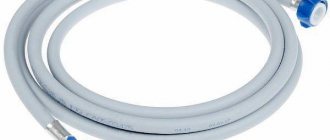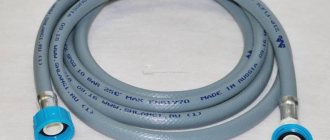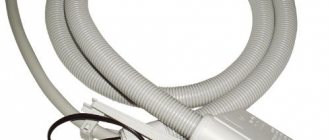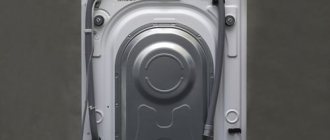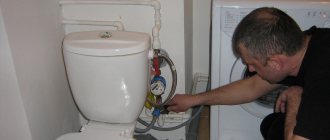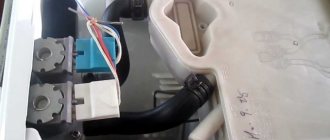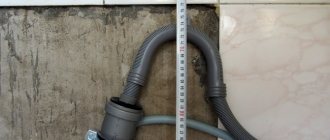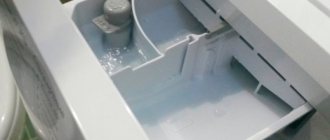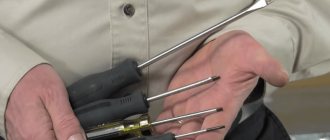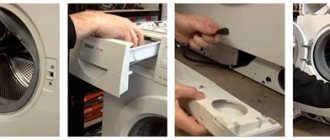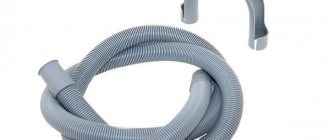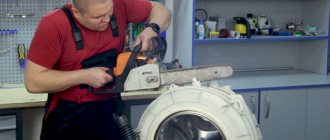In some cases, the reason for the formation of a puddle under the washing machine is that the inlet hose of the washing machine is leaking. Despite the apparent simplicity of the problem, it is sometimes not immediately possible to effectively solve it. As a rule, it always seems that it is enough to tighten the connection of the hose to the machine or to the water supply system more tightly, and the leak will stop.
But it doesn't always work out that way. Let's go through the entire inlet hose and figure out where a leak may appear:
Incorrect position of the hose relative to the connection itself
It is important that the hose is correctly positioned relative to the threaded connection with the machine or with the water supply tap. The plastic, flat part of the hose that is adjacent to the rubber gasket should be perpendicular. If, under the weight of the hose, the plastic part presses unevenly on the gasket, then a leak occurs in a weakened area.
To eliminate this, it is necessary to position the inlet hose so that uniform pressure is applied to the rubber gasket.
[custom_ads_shortcode2]
option for manufacturers Samsung, Indesit, Ariston, LG, Ardo, Beko, Whirpool, Candy
You can get to the inside of the drain hose in machines of these brands from the bottom of the case. To change it, the course of work will be like this.
- First you need to remove the base panel that covers the pump filter.
- The filter is unscrewed and the remaining water is drained.
- Now the washing machine needs to be tilted. To do this, you need to move the machine 30-40 cm towards the wall and tilt it so that it rests on the wall.
- Tilt the machine and unscrew the screws located below; this can be done with an angle screwdriver.
- Having reached the inside of the hose, you can remove it by loosening the clamp.
- Before completely disconnecting the old one, it would be a good idea to take a photo of how it is secured in order to install the new one correctly later. After unfastening the hose completely, pull and remove it from the machine.
- Now you need to install a new one and secure it with a clamp, after which everything needs to be assembled in the reverse order.
- Connect the outer end of the hose to the sewer system. The connection must be checked for leaks.
Article on the topic: Is it possible to wash nubuck shoes in a washing machine?
Connection of the rubber and plastic parts of the hose
A leak may occur in the hose itself, where the rubber part is connected to the plastic part using an iron clamp. As with the gasket, the rubber hose loses its elasticity over time, and accordingly the pressure of the iron girth weakens and water begins to leak through the connection.
Leaks occur more often when the machine is moved and the old connection is disturbed. To eliminate the leak, you need to correct and firmly fasten the hose to the back wall of the machine. If this does not help, replace the inlet hose.
[custom_ads_shortcode3]
Replacing the pipes between the valve and the dispenser
Having noticed a puddle under the washing machine, you must immediately look for the leak. The first step is to check the dispenser pipe. It is necessary to remove the top cover of the machine and find in the left corner the hose connecting the filling valve to the powder receptacle. The hose is held on by clamps tightened at both ends. To ensure its integrity, you should:
- using pliers, loosen both clamps;
- move the “rings” to the middle of the pipe (do not tear them off, they are reusable and will be useful during reassembly);
- unhook the pipe from the intake valve fitting;
- remove the hose from the powder receiver fitting;
- Carefully inspect the hose for cracks, blockages and other defects.
The pipes must be intact, clean and flexible - otherwise there is a high probability of leakage!
If the rubber is intact and flexible, then just rinse it in warm water and go over the corrugation with a bottle brush. Afterwards, the pipe returns to its place and is fixed with clamps. A damaged or hardened hose must be replaced - an analogue is selected according to the serial number of the existing washing machine.
Damage to the rubber part of the hose
When kinked or mechanically impacted, as well as over years of operation, the most basic, rubber part of the hose can become damaged. Sometimes a leak occurs in a hard-to-reach place and the cause of the leak cannot always be immediately determined. In this case, it is necessary to disconnect the hose and check it in a visible place.
It is better to replace a damaged hose, since the water in it is under pressure, and there is no guarantee that the glue will last long.
If you notice that your washing machine has started to leak, this can happen for various reasons. Including due to a leak in the inlet hose. At first glance, it seems that solving the inconvenience that has arisen is not quite difficult. But it is not always the case. And this malfunction can cause some problems. You may decide that in order to fix the damage, you just need to tighten the hose connections harder. Unfortunately, this method does not always help. Let's take a closer look at this issue and discuss the typical places in the hose where leaks most often occur. And some reasons that can cause this.
[custom_ads_shortcode1]
There is a leak (dripping) from under the flexible hose nut, how can I eliminate a flexible hose leak?
Water drips from under the hose nut and does not even flow in a large stream.
How to fix a leak from under the hose nut?
First, you need to decide where it’s leaking from, otherwise it will be like mine, I changed the gasket twice, but it was leaking from under the seal.
So, you need to find the cause of the leak, to do this, turn off the water, drain it from the pipe and dry the joint well, first with a rag, then with a napkin or toilet paper, if you don’t have time, but if you have time, just let the joint dry.
When you connect the water (it is best to use the help of a friend so that you can be near the flexible hose when the pressure is applied), you need to carefully examine the place where a drop of water will begin to appear.
Not a reliable enough connection
One of the reasons for a water leak may be an insufficiently reliable connection between the hose and the water pipe or washing machine. Or wear of the rubber gasket, which is located at the joints of the hose. Over time and under the influence of mechanical factors, it may slightly change its shape. May become less elastic. This is what will cause a leak. Typically, this problem occurs after moving the washing machine. Or after moving it to another apartment and a new installation.
In order to get rid of this problem, it is enough to buy a new gasket and install it in place of the old one. Gaskets can be purchased at plumbing supply stores. In order not to be mistaken in size, you can take an old gasket with you and compare it with the one you will buy. Gaskets cost mere pennies, there are usually quite a lot of them in such stores, so there shouldn’t be any problems with the purchase.
[custom_ads_shortcode2]
Leakage when washing
It can be difficult to notice that the device is leaking during operation, because at first the traces may be minimal, they can easily be attributed to the proximity of the sink or laundry from the last time. But if water flows in the washing machine precisely during the washing cycle, that is, longer than during filling or rinsing, the situation will very quickly worsen and can damage the internal elements of the device, it may be impossible to restore them
Therefore, pay attention to even small puddles under the device during operation and check the most vulnerable components:
- Drum. After use, check the drum for integrity, the presence of holes and try to protect it from sharp zippers, buttons, snaps, etc. Because if the tank leaks, replacing it, especially in the expensive brands Zanussi, Miele and AEG, can cost up to 50% of the price of a new car.
- Upper part of the seal. The rubber gasket creates a tight seal inside the tank and protects against leaks. When using aggressive powders or acids for cleaning, the sealing lip may become leaky. Even if the hole is at the top, moisture will still leak out in the gentle wash mode. If you find damage, immediately call a technician for a replacement, and when you call, tell the make and model of the device so that the specialist can immediately take the necessary spare part with him.
- Drain filter. Each user should check the filter regularly for debris. But if you have not tightened the plug tightly or it is damaged, there will be leakage from this hole. If a puddle has formed below and directly under the filter, first make sure it is screwed on tightly.
Incorrect hose position
It is necessary that the hose is in the correct position in relation to the connection points with the washing machine and the water pipe. The part of the inlet hose that is made of plastic and is located inside under the rubber gasket must be in the correct position. Such that, in a twisted state, it will evenly press on the gasket from all sides. If there is less pressure in some part, then water leakage may occur there.
If this is the problem of leakage, then it is enough to correctly place the inlet hose of the washing machine and tighten its connecting points a little more tightly.
[custom_ads_shortcode3]
The process of preparing for repairs
How to proceed to prepare the washing machine to eliminate a leak from below:
- Shut off access to water,
- Remove the inlet and drain hose (the hose, not the pipe!)
- Place a cloth on the floor
- Remove the washing machine dispenser,
- Remove the hose from the service hatch from below and use it to drain the water that remains in the system from the hatch,
- Remove the drain filter, clean it at the same time or replace it,
- Tilt and lay the washing machine on its side.
Completing all of the above steps will ensure safe and comfortable work. The water must be drained to prevent the board from flooding and, consequently, damage. For further work you will need a “–” screwdriver and pliers.
Poor joining of plastic and rubber components in the hose
A leak may also appear inside the hose. Where its plastic and rubber components meet. They are fixed to each other using a metal frame. The reason may be that the part of the hose that is made of rubber has lost its elasticity over time, worn out, and changed shape. In such a situation, the pressure of the fixing metal band may become weaker. And this will lead to a leak.
This problem also occurs when moving the machine, changing its location or moving. If this malfunction occurs, you should try tightening the fastener further. You can also fix the hose in a position in which water will not leak. But all these are just temporary solutions. And we do not recommend resorting to them because the leak may resume. The recommended solution to this problem is to replace the hose. You can easily find a new hose in stores that sell plumbing supplies. The hoses are again not expensive and such a purchase will not put a strain on the family budget.
[custom_ads_shortcode1]
Leakage when rinsing
There are few situations when the washing machine leaks already at the stage of rinsing clothes, but if you find this problem, call a specialist, because you won’t be able to eliminate the causes on your own. Here they are:
- Bearing wear. This is a serious malfunction because the bearings are responsible for the mobility of the drum. If they have worn out, lost their properties and even caused a leak, you will definitely need professional help. To find out if there really is a problem with them, turn the tank with your hands in the off position. If you hear creaking, knocking and other extraneous noises, and the drum itself is tight, the bearings need to be replaced. Such repairs are not easy; you have to open the systems, and sometimes cut the tank. Samsung equipment is quite easy to disassemble.
- The cuff is leaking. If the seal has damage at the bottom, it is difficult to notice them, because there are many folds in this part, and it leaks from under the body. Check the integrity of the cuff regularly.
Whatever the reason that leads to leaks, they cannot be ignored; it is better to contact the trusted Remontano service by phone.
Replacing the hose
Replacing the inlet hose is very simple. You just need to turn off the water supply. Then unscrew the old hose from the water supply and from the washing machine. And then screw on the new hose. After this, open the water supply and examine the hose for leaks.
If you did everything correctly, then they will not exist. If they appear, it means that you did not tighten the connections tightly enough, or you lost the gasket. You also need to pay attention to the fact that these places cannot be twisted. Because if you tighten it too tightly, you can strip the threads or damage the gasket. And if you have a lot of strength, then do it carefully.
It also happens that there is a leak from the rubber part of the hose. It appears due to improper use, mechanical damage and other cases. With such a breakdown, there is no need to be too smart. You can simply replace the damaged hose with a new one.
Any household washing machine must be connected to a cold water supply and a sewer system to drain waste gray water. To connect to the water supply system, a separate hose for the washing machine is used, which comes with the unit; a second flexible line is used to send wastewater to the sewer.
In most washing machines, the water supply hose is not long enough to connect to the water supply - in this case, the consumer is faced with the task of choosing a suitable replacement from a number of similar or more technically equipped hoses. Sometimes the user has problems when the drain hose built into the washing machine is damaged; replacing it requires some technical knowledge.
Inlet hoses for washing machines.
[custom_ads_shortcode2]
Causes of leakage
To recognize the real causes of a leak, you need to carefully examine all possible problem areas. Diagnostics are performed after disconnecting the device from the network. It is also better to disconnect the hoses to free up space for moving the unit. There can be many reasons for a leak. Here's just a small part of them.
Incorrect operation
It leads to the fact that the washing machine does not work at full capacity, and blockages occur. If you follow all the recommendations for cleaning the filtration and drain systems, the risk of a leak will be minimal. A problem may arise if the hoses become mechanically damaged. Children and pets can become a source of danger.
If the leak is not under the body of the machine, but in front, you should pay attention to the condition of the cuff. They are the ones who most often suffer from mistreatment
Incorrect selection of chemicals
When, upon inspection of the washing machine, obvious traces of water leakage from the powder loading compartment are discovered, the cause may not only be a blockage. If too much detergent is added, or it has a higher foaming capacity than necessary, the excess foam will find its way out through the joints of the tray.
Manufacturing defects
Sometimes washing machines, even those produced by the most famous manufacturers, have a manufacturing defect if the cause of the leak is the failure of one of the system elements. Leaks are most often caused by the installation of low-quality seals and pipes - parts that are quite easily replaced under warranty.
Breakage of parts
As a rule, leaks are associated with the breakdown of parts only if we are talking about the drain system. In this case, a leak will occur during the spin or rinse stage, when water is discharged from the system. If the pump is faulty, water will accumulate at the back wall. A leak also forms there if the seals or drum bearings fail. A leak at the dispenser may be due to damage to the drain valve.
When water leaks through the cuff, you should definitely pay attention to the operation of the pressure switch. If this sensor, responsible for controlling the water level, fails, overflows will inevitably occur in the drum
Purpose of hoses for washing machines
A standard inlet hose for a washing machine is a smooth-walled polyvinyl chloride (PVC) tube up to 5 m long, reinforced on the inside with polyester, polyamide or nylon thread. Straight and corner fittings with sealing rubber gaskets made of PVC or polypropylene (PP) are pressed into the sleeve using aluminum sleeves along the edges. The filling hose has a diameter of 10 mm; plastic union nuts with an internal diameter of 3/4 inches are used to connect to the nozzles of the washing machine and water pipes.
It should be noted that many hoses for washing machines are used when connecting dishwashers to the water main.
The drain hose for a washing machine is a corrugated PVC tube designed to transport liquids with high temperatures. Depending on the brand of the washing machine, the diameters of its outer pipes have different sizes. The standard widths are 19 and 22 mm; in many imported models, the pipes have a diameter of 24 and 28 mm, and one of them may also have an angular design.
Connecting pipes for pressure hoses Water hoses for washing machines perform the following functions:
- Supply cold water to the unit when washing clothes. To do this, one of the ends of the liner is equipped with a fitting with a rubber gasket, which is attached to the pipes using a union nut with an internal thread. During operation, the hose must withstand the maximum pressure in the water supply system, the standard value of which, according to GOST, is 6 bar.
- Gray waste is discharged into the sewer system after washing. To make draining into the bath easier, the end of the sleeve is placed in a horseshoe-shaped plastic guide.
- Thanks to the built-in filter, the inlet hose protects the washing machine from sand and dirt getting into its drum.
- Some models of modern supply hoses, in addition to transporting water to the washing machine, are capable of performing protective functions, preventing flooding of premises if the tightness of the system is broken or the supply line is broken.
Drain hoses - appearance and cost.
[custom_ads_shortcode3]
Installation and operation
Before you begin installing the equipment, you must definitely decide on its permanent location. Moving the device to another location will require additional physical and financial costs. At the beginning of the connection stage, you need to install a special tap with an external thread, which will connect the inlet hose to the water supply. A prerequisite is to shut off the water valve, which ensures the flow of water into the apartment.
The tightness of the connection is ensured by rubber gaskets, which can be purchased independently or used from the device kit. When connecting parts, it is necessary to avoid twisting the pipe and the appearance of creases and kinks on it. If it is not possible to purchase a special inlet hose, experts recommend making an alternative protection system, which consists of a tray with a built-in float. This kit is installed under the machine.
If it is necessary to replace an old device with a new one, novice craftsmen need to know the basic rules for replacing the inlet hose:
- purchasing a new pipe of the required size;
- shutting down the central water supply system;
- disconnecting a damaged hose;
- connecting a new device according to the manufacturer's instructions indicated on the packaging.
To increase the length of the inlet hose when moving the machine to another location, it is not necessary to purchase a completely new pipe. Experts recommend applying a set of the following measures:
- determining the missing hose length;
- purchasing a direct connection hose of the missing size;
- purchasing an adapter with external thread;
- connecting the system using fum tape;
- connecting the system to the tap.
Recommendations from experienced specialists:
- the use of grease will extend the service life of threaded connections;
- the absence of water on the fixing elements will prevent the appearance of corrosion and rust;
- free movement of the union nut will prevent water seepage;
- installed water filters will prevent debris, rust and limescale from entering the hose and extend its service life;
- if a breakdown occurs, you must immediately stop the entire system;
- Be sure to turn off the water supply tap after completing work.
Experienced craftsmen recommend observing not only the technical rules and regulations for the operation of devices and plumbing, but also knowing and applying the general requirements for the use of modern household machines, which will allow this type of equipment to be used without repair for decades. To extend the life of your dishwasher, you must follow these rules:
- correct placement of dishes in the washing tray;
- regular washing of the mesh drain;
- timely cleaning of the shower blade holes;
- annual cleaning of door seals;
- regular use of special cleaning products.
Basic rules for operating a washing machine:
- correct sorting of laundry;
- precise selection of washing mode;
- compliance with washing rules and the sequence of operating mode selection;
- using high-quality detergents;
- compliance with standard equipment care standards.
In specialized stores of household appliances you can see a huge number of products, the purpose of which is to facilitate and simplify numerous household chores and responsibilities. The top sellers of these stores are washing machines and dishwashers, which every housewife can no longer do without. The use of this technique allowed women to devote more time to family and work. In order for the selected device to last for decades, you must take a responsible approach not only to the purchase of the product, but also to its proper installation and operation.
To learn how to select and connect the inlet hose from a washing machine and dishwasher, see the video below.
Types of inlet hoses
The inlet hose for the washing machine, in addition to the drain hose built into its body, is always included in the delivery package, and the following types of pressure hoses are available:
- A simple single-layer tube made of durable rubber or polyvinyl chloride is the most budget option.
- Double-layer hoses reinforced with synthetic thread are the main types of hoses used in most washing machines. In some types of hoses, to increase strength and increase service life, the manufacturer strengthens the outer shell with nylon braid.
- Tubes with two shells for Aquastop systems. The inner one is a regular hose reinforced with synthetic thread, the outer one is an auxiliary element of the protection system and, depending on its type, performs different functions. In some types of leakage protection systems, an electric wire is laid between the shells, supplying control voltage to the Aquastop locking unit. In other designs, the second shell serves to supply water when the hose is damaged to the powder adsorbent associated with the shut-off valve.
The principle of operation of a mechanical valve Manufacturers of imported washing machines pay great attention to safety; their products are often equipped with automatic leakage protection systems. Aquastop systems built into washing machines come in several varieties, the main ones:
With mechanical valve . The main components of the Aquastop mechanical valve are a conical seat (gate) and a spring-loaded core, which in the operating position are at some distance from each other and water flows quietly through the gap between them. When the tube breaks, the speed of the water flow increases, the pressure behind the conical core drops, and it begins to move towards the valve until it completely blocks the water supply channel. A closed valve can only be returned to its operating position by equalizing the pressures at the inlet and outlet, so to restart you will have to turn off the water and unscrew the mechanical Aquastop valve.
The disadvantage of this device is that it reacts only to a complete break in the supply tube; with minor leaks and when water is simply dripping, the pressure drop is too small for the valve to operate.
Water Block - appearance and principle of operationWater Block blocking valve. This protection system works on the principle of dosing the volume of water consumed. A rotating mechanism is built inside the system that responds to the movement of water flow (an analogy can be made with a water meter).
Before starting the machine, the user sets on the device body the volume of water consumption for one wash; to do this, he rotates the moving part until it matches the desired digital symbol. Numbers from 1 to 10 indicate the volume of water consumed when the set value is multiplied by 5 liters.
When a water flow passes through the Water Block, the mechanism inside its body rotates, and as soon as the volume of flowing liquid reaches the set reading, the shut-off valve rises and instantly closes the water supply channel.
Appearance of a sleeve with powder Aquastop Powder adsorbent. In this protection system, the hose consists of a double shell, the outer drainage has a corrugated structure. An adsorbent is located between the outer and inner walls, water is supplied to the washing machine through the central hose, and the locking unit is located near the inlet pipe of the hose.
If the inner tube is damaged, water enters the space between the hoses and reaches the adsorbent (to do this, the hose is installed with a slope towards the Aquastop unit), which expands in the presence of moisture. The powder is mechanically connected to the shut-off valve (plunger), so when the filler volume increases, the shut-off element moves and blocks the water inlet channel.
In other types of Aquastop powder systems, the shut-off valve is connected to a different-pole magnet, the same is placed in the adsorbent body; in operating condition, their mutual repulsive force is high and the passage channel is open. When the powder gets wet, it increases in volume, the distance between the magnets increases, the magnetic field weakens and the internal plunger blocks the passage channel.
A distinctive feature of these systems is the presence of a built-in peephole, by the color of which you can determine the presence of leaks if the hose is damaged.
Aquastop with adsorbent - internal structure Float sensor. One of the most popular Aquastop systems, it reacts to flooding of premises in the event of a leak in the hose and washing machine, a break in the supply hose and other types of leaks. The operating principle of this device is to place a sensor on the washing tray, which is a foam float with a mechanical switch. The switch itself is connected by a wire to an electromagnetic coil, which is located in the supply hose housing next to the inlet pipe.
When the room is filled with water, the float floats up and closes the switch contacts. Power is supplied to the electromagnetic coil of the Aquastop system via an electric cable through a closed switch; its armature, together with the shut-off valve, moves and closes the inlet water channel.
The advantage of this system is protection against flooding of premises in the event of any type of leakage, so it is often used not only in washing machines, but also in dishwashers.
Float sensor - structural device
Types and device
The design may vary. Manufacturers have developed several different methods, which have their own advantages and disadvantages. The inlet hose protection is:
Mechanical. It is used quite rarely, but is still found in inexpensive Bosch models. The design includes a spring and a valve. When a leak occurs, the pressure rises, the spring reacts to this and the valve closes.
Mechanical method of protection
It is not used so often, for example, on inexpensive Bosch dishwashers. The device consists of a spring with a valve. The spring is designed for a strictly defined operating pressure: when there is a leak, it immediately drops, the spring is triggered, and the flow of water is blocked by the valve. The disadvantage of this method is that the system does not respond to small leaks, only floods.
Absorbent protection
This system is more common and is used more often. Its operating principle is simple: when there is a leak, water flows into a container with an absorbent; as a result of contact with water, the absorbent begins to swell and expand, as a result, it helps to stop the supply of water to the “dishwasher” using the valve. A device using an absorbent is equipped with a spring or plunger. The disadvantage of the system is that the absorbent, after increasing in size, hardens and blocks the valve. It is impossible to use it in the future; the hose also needs to be changed.
Electromechanical method
The principle of operation is similar to the absorbent type of protection. The difference is that instead of an absorbent, 1 or 2 solenoid valves are used here, depending on their types. This is the most reliable Aquastop protection device. Based on research by specialists, the device “fails” in very rare cases.
How to choose hoses
When choosing an inlet hose for an automatic washing machine, pay attention to the following factors:
- When connecting the washing machine, the water supply hose must be in a freely lowered state without sharp bends, twists or loop bends. Therefore, to correctly determine its length, measure the distance from the inlet and outlet fittings and add 70 - 100 cm to the measured value (the height of the washing machine is added).
- All water supply pressure hoses for washing machines have a significant pressure reserve and are designed to work in systems with pressure from 10 to 70 bar; hoses with Aquastop have the highest hydraulic characteristics. Therefore, any hose is suitable for a regular washing machine, especially since the products have standard fittings with a union nut with an internal diameter of 3/4 inches for connecting the unit to the water supply system.
Aquastop hoses for working with a float sensor are a structural device.
- If it is necessary to extend the drain hose, then when purchasing you should pay attention to its temperature resistance. In some models, the extreme limit is 90 ° C, and if washing machines use the boiling function, the heat resistance of this sleeve may not be sufficient. To avoid problems with high temperatures of the drained water, select a hose with the appropriate parameters.
- To organize flood protection using the Aquastop system for washing machines that do not have a built-in float switch, a hose with a shut-off system made of powder adsorbent is often purchased. It should be taken into account that this design has low functionality and protects the premises from flooding only in the event of damage to the hose supply.
Washing machine connection diagramIn order to prevent leaks when operating a washing machine, it is useful to know the main reasons causing this malfunction. These include:
- Damage to the casing of the falling pressure hose. Most often it is caused by mechanical stress, improper operation in too warm or cold rooms, or prolonged use, as a result of which the shell loses its elasticity and cracks appear in it. For any type of damage, the hose needs to be replaced; due to its low cost, there is no need for independent repairs.
- The filter built into the hose may become clogged. In this case, excess pressure often causes a leak to appear anywhere in the system. To carry out repairs, remove the hose and clean the filter, after which the liner is put back in place.
- Loosening of the clamping nuts and wear of gaskets can also cause leaks. To troubleshoot problems, the hose is disconnected, the gaskets are changed or the union nuts are tightened.
- Leaks can cause damage to your washing machine. Often, over time, internal water supply tubes lose their physical properties and water can penetrate into the room through cracks in their shell. Often, during operation, the rubber door gasket loses its elasticity, and water leaks through a loose connection. In these situations, washing machine repair specialists are called to troubleshoot problems.
Stages of replacing the drain hose If the inlet hose is damaged, replacing it will not be difficult even for a schoolchild. To do this, purchase a product of similar length, remove the damaged sleeve by unscrewing the union nuts manually (do not forget to turn off the water supply ball valve), and connect the purchased product in its place.
The situation is more complicated if it is necessary to replace a drain hose that has been damaged during operation. Since the sleeves of many machines differ in their dimensional parameters, instead of the old one they usually purchase a product designed for a specific brand of washing machine (Electrolux, Samsung, Indesit).
Before changing the drain hose in the machine, disconnect it from the power supply, disconnect the pressure filling hose from the body, then carry out the following operations:
- Lay the car on its side and remove the back wall, unscrewing the fixing screws with a screwdriver.
- Determine the entry point of the drain hose into the water pump, and then remove its fastening by unscrewing the clamping clamp.
- Remove the old hose from the washing machine and take a new product. To install the drain hose in its place, insert the hose through the hole in the body, put it on the outlet pipe of the pump and clamp it with a clamp using a screwdriver.
- Upon completion of installation, install the back cover in place, screwing it in place.
Popular inlet hoses and their costs.
[custom_ads_shortcode2]
Troubleshooting
After turning off the machine and de-energizing it, disconnecting it from the water supply, we perform an external inspection to determine why the water is leaking. To carry out this inspection, you may need to tilt the washing machine or remove the back or side covers of the machine. It will be much easier to find the faulty part if you have determined at what cycle of operation the leak began to appear.
Hose damage
Damage to hoses, their premature wear and poor connection at the joints is the most common reason why a machine may leak.
Inlet hose leak
A leak in the inlet hose can be detected even when the machine is not running. If you have established for sure that there is a defect in the inlet hose, then it is not advisable to repair it, since the water pressure supplied to the washing machine system is quite high. If necessary, this hose must be replaced with a new one. And if the seal is broken at the junction of the hose with the machine components, it is necessary to change the gasket and tighten it well. In order not to break the plastic elements of the hose, you need to clamp it exclusively with your hands without using additional tools.
The drain hose may be leaking
Leaking pipe
If there is a leak during water intake, which disappears after filling the tank, the most likely cause may be damage to the pipe connecting the fill valve to the powder receiver hopper. To carry out an external inspection of this unit, you will need to remove the cover from the Samsung washing machine.
Damage to the drain pipe can also cause water to leak from below. This pipe connects the tank to the drain pump. To examine it, you need to look from below, after tilting the washing machine.
poor connection between the pipe and the tank
Damage to the drain pump
If, during washing, you find water leaking in the area of the drain pump from below, then perhaps it has become unusable or damaged. To carry out a high-quality visual inspection of this unit, it must be completely dismantled. A faulty drain pump must be replaced, so professional assistance may be required.
The cuff is leaking
When washing laundry, in which careless owners sometimes forget some small items in their pockets, the sealing collar of the washing machine door may be damaged. Such damage is clearly visible in machines with horizontal loading of laundry.
If the damage is not very large, then it can be repaired using a rubber patch and special waterproof glue. After sealing the hole, it is better to turn the cuff over with the patch facing up, since with this arrangement the water load on it will be less, which can increase its service life. If the seal is damaged internally, it must be removed from the unit.
Of course, it is advisable to replace the defective cuff with a new one.
Damage to the washing machine tank
To inspect the tub of a top-loading washing machine, you will need to tilt it to check the bottom for water droplets from below. It is good to use a hand-held flashlight. If the washing machine is top-loading, you will have to remove the side wall. Tank failure may occur due to the presence of foreign solid objects or a malfunction of the heating element.
If the tank consists of two halves, then the leak may occur due to the drying out of the sealing gasket between them. Such a malfunction is extremely rare and requires replacement of the gasket.
Oil seal malfunction
As a rule, a malfunction of the oil seal during washing is difficult to determine; it becomes noticeable when the machine is operating in spin mode. If you notice that the tank seal is leaking, you must immediately stop operating the machine to avoid more serious damage to the unit.
Repairing such a malfunction involves replacing the worn oil seal or bearing with new parts. Such work requires the involvement of washing machine repair professionals from the workshop.
Leakage through the dispenser
Water may leak during washing if the dispenser hopper is clogged with powder residue or a foreign object. To eliminate the cause of the leak, you need to remove the dispenser and clean it and the hopper from obstructive contaminants.
Leakage through the dispenser is also possible due to excessive water pressure in the system and due to problems with the inlet valve. This problem can be eliminated by reducing the water pressure.
Manufacturers
Almost all drain hoses sold in the retail chain are produced by washing machine manufacturers. The most famous of them are Bosch, Candy, Indesit, LG, Samsung, Electrolux, Atlant, Veko. Depending on the brand of the unit, each product has its own alphanumeric designation, indicating compliance with a specific model of the washing machine.
The situation is different with inlet hoses, the connecting dimensions of which are unified. The product is represented on the market by a wide range of domestic, Chinese, and European manufacturers. The most famous brands are Aquatechnic (Russia), Magic Power (China), Swedish Electrolux with aquastop, Turboflex (Russia), Reflex (Italy).
Modern inlet hoses for washing machines are capable of not only supplying water to the units, but also protecting the premises from flooding in the event of various types of leaks thanks to the built-in Aquastop systems. The consumer has the opportunity to choose any filler and drain hose that suits the model of his washing machine at an affordable price from a wide range of products from domestic and foreign manufacturers.
To supply water to washing machines, they are connected to the water supply using an inlet hose. Most often, a branch is made that has a tap so that you can instantly turn off the water supply. The inlet hose for the washing machine comes included with the appliance itself - there is no need to purchase it additionally.
However, what to do if you need to replace it? Replacement may be required for a variety of reasons: a leak, a damaged shell, inappropriate length, or a low-quality standard part. To purchase a truly high-quality hose for a washing machine, you need to know their types and how much a high-quality inlet hose costs. This is exactly what will be written below.
[custom_ads_shortcode3]
Leakage when filling with water
If you find that water is leaking in the washing machine already during the cycle, stop the cycle and turn off the water supply. We do not recommend disassembling the entire system to find a defect. But you can find the cause of the problem. Here are the most common ones:
- The supply hose is damaged. Most often, the plastic hose is damaged mechanically. If you examine it carefully, you can easily see the hole. But sometimes the hole is small or in a hard-to-reach place. To detect it, try using a popular test with toilet paper: wrap it around the entire length of the hose and turn on the water supply for a few seconds. The leak is located in the place where the paper is wet.
- The filler pipes are worn out. If this part is made of low-quality material, after 3 years of regular use it will fail. This often happens with Ariston and Candy appliances. If moisture flows below during intake, it means that the pipe is broken. It can be replaced or repaired.
- The powder dispenser is clogged. Sometimes when filling, foamy liquid flows from above the panel from under the powder receptacle. This means that you usually add too much product and it cannot completely dissolve, but only gets wet, hardens and clogs the duct. If possible, remove this container and clean the area behind it with your hands (under no circumstances should you put sharp objects in there). You need to be especially careful with Hansa and Indesit models due to their narrow channels. If the problem cannot be resolved, it is better to contact the specialists from Remontano.
Types of inlet hose
Inlet hoses for a washing machine have a very simple design. At the base of the inlet hose there is a small polyvinyl chloride pipe, which is reinforced with reinforced thread, as well as nylon braid. This filling device consists of several layers, which allows us to hope for its strength - they have sufficient resistance to rupture and are ready to withstand high water pressure.
At the end, the filling hoses are reinforced with metal sleeves, fittings and nuts are visible from it. One fitting is screwed to the washing machine, the second to the water pipe. Fittings and nuts are made of plastic. They are not particularly strong, so they are tightened by hand rather than with a wrench - this will save them from damage.
This design of the inlet hose is very common - this is how they come in the set with the washing machine. Usually they have a certain length. When the washing machine is not installed near the water supply, an extended inlet hose will be needed to supply water.
These tubes can be purchased separately; the length of such a hose varies from 1 to 6 m. If necessary, the length can be made larger by connecting two or more inlet hoses using connectors.
FUM - tape can be used to seal the joints to avoid water leakage. However, it is better to exclude such connections, since they cannot be called reliable.
Is it possible to disassemble the inlet hoses for washing machines? Of course you can do this. However, it is recommended to throw out a damaged inlet hose and buy a replacement. This way you will avoid possible leaks during water supply - new inlet hoses are, of course, more reliable and have serviceable fittings, which is not to say about an old hose that has been repaired.
See also -
Why doesn’t water flow into the washing machine - what to do?
[custom_ads_shortcode1]
Repair methods
Repair methods depend on the model of the washing machine, design features and the identified cause of the malfunction. In most situations, repairing individual components is sufficient to restore functionality.
Replacing the water supply hose
If a leak is observed at the junction with the tee in the water supply system or at the connection to the housing, it is enough to install a new gasket to fix the problem. If you find a leak on the hose itself, you will need to replace it. To do this, you need to select a hose of a similar size.
If the problem is in the filter
When the filter is malfunctioning and allows water to leak due to loose fittings, you can easily fix the problem yourself. You just need to tighten the fasteners using pliers.
Cleaning the dispenser from deposits
You can clean the detergent dispenser grid from plaque and accumulated dirt with a strong stream of water. To do this, the compartment is removed from the housing and thoroughly washed. If there is heavy dirt, you should use a cleaning agent.
Replacing the intake valve pipe
If there is a leak in the pipe that is responsible for letting water into the tank, you can do without replacing the part. When the damage is at the connection point of the pipe, you need to coat it from the inside with rubber glue and press the part tightly. It takes about 15-20 minutes for the adhesive to dry and restore the connection.
Repair of the pipe that is responsible for collecting fluid
If the pipe that supplies the fluid has loose clamps, you can fix the problem by tightening them. If a serious breakdown occurs, the component must be replaced.
To diagnose the condition of the pipe, you need to proceed according to the following scheme:
- Remove the lid of the washing machine and find the tube that connects the water intake valve to the powder compartment. The pipe is held in place by fasteners on both sides.
- Using pliers, loosen the clamps and move them to the central part of the pipe.
- Carefully remove the pipe from the valve and cuvette outlet.
- Inspect the part and check for blockages. If available, you can use a bottle brush.
Replacing the rubber cuff
Most modern washing machines are designed in such a way that replacing the sealing lip does not require disassembling the body. The cuff is secured with two clamps. To remove the outer clamp, you need to bend the elastic band and pry the clamp with a thin screwdriver, pulling the cuff towards you.
To disconnect the internal clamp, remove the front panel of the machine. The process of disassembling the panel depends on the specific type of washing machine. If you cannot disassemble the equipment yourself, you should entrust the work to specialists.
Replacing the drain pump
Most washing machine manufacturers install non-separable drain pumps, so repairing them is not possible. In addition, separate repair kits are not available for models with a dismountable pump. It is possible to fix a problem in the operation of the drain pump only in a situation where its parts are intact and the pump is simply clogged.
If the blockage is not cleared in time, this may cause overload of the pump motor or breakdown of the impeller. Having discovered the first signs of a malfunction, you need to carry out diagnostics and, if necessary, replace the part.
Tank replacement
In case of mechanical damage to the tank, it is possible to eliminate the leak only by replacing the element. The old tank must be removed and the new one installed through the top of the machine.
Replacing the oil seal
The process of replacing the oil seal is labor-intensive and requires a series of steps to be performed sequentially. In particular:
- remove the top panel, back and front walls of the machine;
- remove the counterweights and disconnect the shock-absorbing springs;
- disconnect electronic and mechanical control units, remembering the location of the wire for reassembly;
- remove the tank and separate its parts from each other to gain access to the bearings and oil seal.
Before replacing the oil seal, it is recommended to inspect the condition of the crosspiece and shaft. If the washing machine operated in emergency mode for a long time, defects could form on the elements, and then replacing the seal would not bring the desired effect.
Inlet hose with Aquastop
A design that is protected against leaks is called Aquastop. The simple hoses mentioned above can break - this happens due to natural wear and tear. If there are water leaks, you can easily flood your neighbors. Hoses with the Aquastop system neutralize this possibility.
A hose with an Aquastop protection block is a design where 1 tube goes inside the second. There is a special material between them; when water gets on it, it swells, which triggers the protection valve, which shuts off the water. The system operates as follows:
- normal mode - water flows through the internal, main inlet hose;
- if it is damaged (rupture or slow leakage), water acts on the swelling material;
- the material swells and the valve is activated, shutting off the water, leaving the floor in the building dry.
These hoses are more expensive than classic hoses, but they provide a guarantee of protection against possible leaks. It also happens that the washing machine, even when not working, produces water, in which case the hose with the AquoStop system will not help you.
[custom_ads_shortcode2]
Machine diagnostics and repair tips
Typically, questions about what to do when a leak is detected in the washing machine arise when it is used for a long time without maintenance or due to the owner’s carelessness. For example, a puddle at the bottom of the door is usually due to the fact that objects not intended for washing have entered the drum. In addition, almost any part of the flexible hose can become leaky.
Water accumulates at the door
Water leaks onto the floor from the hatch if the sealing lip does not fit tightly. It may receive mechanical damage when it comes into contact with objects that fall inside the drum. If the seal gets caught in the door ledge when closing it, there is a risk of rupture. With prolonged use, the sealing of the rubber ring may be damaged - it is restored using special compounds.
You can repair small tears and damage to the cuff yourself. An elastic patch made of a material similar in composition can easily be applied to rubber glue. To repair, the part is removed from the mount by loosening the clamp. After placing the patch, the cuff is installed so that the repaired area is above the top of the hatch, under the “roof” of the unit.
The powder tray is leaking
When liquid leaks from the powder compartment under the tray, the cause may be too much water pressure. In addition, if the detergent is not washed out well, it can gradually form a clog in the hopper itself, the outlet or the filter installed there. Sometimes the problem is due to poor quality water leaving calcified deposits inside the powder receptacle.
Fixing a leak in the tray area is quite simple. You can remove mechanical blockages by removing the powder receptacle and thoroughly washing all its parts. The strainer must be cleaned especially carefully. Its contamination most often disrupts the permeability of the system.
Leakage when filling with water
If a leak occurs when drawing water, the machine may have problems with the inlet hose. In the event of mechanical damage, its sealing is broken and cracks are clearly visible on the surface. Sometimes after rearranging furniture or doing other work in the bathroom, the hose gets pinched. If there are no obvious damages along the entire length of the flexible line, but water still leaks onto the floor, you need to conduct a more thorough diagnosis.
The easiest way to determine the damaged area is to disconnect the hose and install a plug on one side. Then it is wrapped in toilet paper and filled with water. A wet spot will appear at the damage site. If the hose is in order, the problem may be that the connection between the flexible line and the fitting is too loose - it is worth checking it and, if necessary, tightening the clamp further.
Leakage during washing
If water gets under the washing machine during the spin or rinse cycle, the problem is in the drainage system. The filter installed here rarely lets liquid through. Leaks usually occur after recent cleaning. If the filter is not tightened tightly, it may leak water when draining. Simply unscrew it and install it in the correct position.
When the machine leaks during washing, a puddle is located in the area where the drain pipe is located; the liquid may remain inside the body or end up under the bottom. The depressurization of the connection is usually associated with vibration effects and cracking of low-grade material. If damage is received precisely at the junction of the pipe with the tank or pump pump, they can only be detected when the machine is completely disconnected from the sewer, after laying it on its side.
The leak may be due to a breakdown of the volute in the pump. If foreign objects get into the drum, they can come into contact with other parts of the system and damage them. Replacing a broken pump is relatively inexpensive; you can easily purchase it in specialized stores and install it yourself.
A leak that occurs at any stage of the wash and continues throughout the entire operation of the machine may be due to a breakdown of the tank. It ceases to be airtight due to washing of products containing metal inclusions. If there is a strong impact, the container cannot withstand it, cracks, and begins to leak water. In this case, you can try to eliminate the leak using polyurethane sealant by completely disassembling the unit and drying it.
Incorrect position of inlet hoses
It is important that it is located in the correct position relative to the connections to the water supply, as well as to the washing machine. The plastic part of the inlet hose located inside must be correctly positioned under the rubber gasket. When twisted, it should exert equal pressure on the gasket on each side. In a place with the lowest pressure during water supply, a water leak can form.
If water leaks for this reason, then it is enough that you position the inlet hose correctly and tighten the joints a little more tightly.
[custom_ads_shortcode3]
How to install aquastop yourself
If you purchased a washing machine without an aquastop, then you have the opportunity to install this system yourself. We will tell you how to do this point by point:
First, you need to disconnect the washing machine from the electricity and water supply; Next, you need to disconnect the hose that supplies water to the structure (At the same time, you can check it and, if necessary, replace the rubber seals (shown as rings) and also clean and rinse the coarse filters); The sensor itself must be installed on the water supply tap, and must be turned clockwise, which is important; Then we connect the inlet hose to the aquastop system; Before completing installation work, you should make sure that everything is in good working order and reliable. This can be done by slowly letting water into the inlet hose, so you can find any problems and fix them.
Additional measures to prevent flooding
There are other ways to prevent leaks in addition to installing special products in the washing machine:
- For the installation of water pipes leading to the technological device, various materials can be used. In general, these are metal-plastic or polypropylene, but there are also copper and zinc-coated metal pipes. The final option has the shortest service life (no more than 30 years). As for metal-plastic, it is better to only use it for crimping models. Polypropylene has proven itself well, but such a pipe will not withstand severe mechanical failure. Experts recommend: it is better not to use taps and fittings made of aluminum. Good pressure in the system is enough for such a small thing to burst, and this will lead to possible leaks.
- In your bathroom, you have the opportunity to have a floor made of special waterproofing material. This move will protect you and your neighbors below from your leaks. If this work is done very competently and correctly, then in such cases the water will flow into the sewer itself. You can only notice the only drawback in this method - the floor level, which will rise during the installation process.
- The correct and definitive decision would be to shut off all riser valves at a time when all the owners are not at home. This is necessary in such cases when your drain hose from the washing machine is already damaged, and if water flows through any crack in the hose, then there is a high probability of a flood at the most unexpected moment. This recommendation comes with every washing machine, but many modern consumers are so confident in the serviceability of their assistant that they simply do not read the safety points written in the manual.
The Aquastop system for a washing machine is a fairly powerful breakthrough in the field of additions to washing structures.
If you purchased your washing machine already pre-equipped
aquastop system
, then you don’t have to worry too much about your machine breaking down and leaking, because with such a system in the washing design, the risk of huge financial losses gradually decreases to zero.
TOP stores of washing machines and household appliances:
- mvideo.ru/- household appliances store, large catalog of washing machines
- holodilnik.ru – Inexpensive store of household appliances.
- techport.ru - profitable modern online store of household appliances
- citilink.ru is a modern online store of household appliances and electronics, cheaper than offline stores!
- ru.aliexpress.com—spare parts for washing machines
Preventing blockages
A clogged drainage tube is most often caused by natural causes. Mechanical is a rarer occurrence. Small items do not often end up in the drain, preferentially remaining in the drum or tank. Following preventive measures will help you avoid blockages:
- Before washing, you need to carefully inspect the item for small items in the pockets. If necessary, remove them.
- Clothes with zippers should only be washed in a machine when zipped.
- Shoes and bras, as well as clothes with decorative elements and accessories, should only be placed in the machine in special cases.
- Use high-quality laundry detergents that contain a water softener.
- Clean the device every 3-4 months by running a wash cycle with citric acid or a special product.
- Wash the filter regularly and inspect the drum for the presence of small objects.
With proper care and preventive measures, blockages can be avoided. If such a problem occurs, then cleaning the drain hose of the washing machine at home is easy. The main thing is to follow all the recommendations described in the article, and also carefully study the manufacturer’s instructions.
Article on the topic: How to connect a netbook to a Samsung TV
What is needed to install a drain hose
To independently connect the SMA Hotpoint Ariston or Samsung drain corrugation to the sewer system, you need to prepare the necessary consumables and tools. So, you will need:
- splitter or “tee” for sewerage;
- “double” or water seal;
- corrugated hose for extension, however, its total length should not exceed 3 m;
- pipes;
- various connectors;
- sealing coupling;
- clamps;
- siphon;
- silicone sealant;
- adapters;
- pliers;
- screwdriver;
- socket and adjustable wrenches;
- perforator and hammer (if the hose is led into the next room).
To better understand the process of connecting a Samsung washing machine, it is recommended to watch a video that shows all the steps in detail.
Attention! All necessary tools, fastenings and consumables are selected based on the complexity of the connection.
